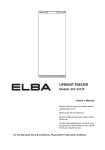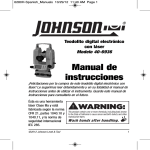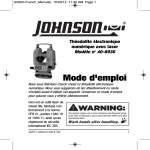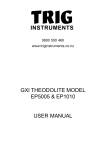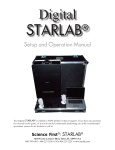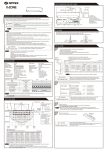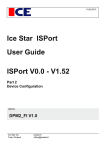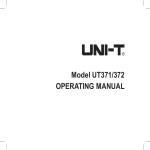Download Operators' Manual Electronic Theodolite FET 420K
Transcript
1 Operators’ Manual Electronic Theodolite FET 420K 2 IMPORTANT! READ THIS BEFORE USING YOUR INSTRUMENT 1. Make a full check for the instrument before using it. Be sure that the instrument’ s functions, power, original settings and revised parameters meet your requires before you operate it. 2. To avoid direct sunlight to the instrument’ s lens, never leave the instrument exposed to extreme heat longer than necessary, or it could affect the instrument’ s accuracy.. 3. When mounting or dismounting the instrument to or from the tripod, hold the instrument by one hand, turn the central screw on the tripod by the other hand to prevent the instrument from falling. If the instrument must be carried on the tripod, hold the instrument as vertically as possible. Never carry the instrument horizontally over your shoulder. Any long distance transport should be done with the instrument in the carrying case. 4. Put the instrument in the carrying case to avoid extrusion, crash and shock during the transportation. Shockproof cushion should be necessarily put inside the carrying case during the long distance transportation. 5. Clean the dirt on the surface of the organic glass and plastic by floss or brush after using the instrument. Dry the instrument in time after use in the rain. 6. Do not use harsh chemicals to clean the surface of the organic glass and plastic components. A water dampened rag is all that is necessary. 7. Use absorbent cotton or lenses tissue to clean the exposed optical parts. Handkerchief, clothes or other things like that are forbidden for cleaning. 8. The instrument should be stored in an area of low humidity and good ventilation, where the temperature will not exceed 110º F(45ºC). It should be necessary to replace the desiccant regularly in the carrying case. 9. Always remove the batteries before storing the instrument. 10. Please contact our corporation if the instrument’ s functions appear abnormal. Non-professional repairers are forbidden to disassemble the instrument. 3 CONTENTS USAGE NOMENCLATURE and FUNCTIONS 1. Nomenclature 2. Display Marks 3. Operating keys PREPARATION BEFORE MEASUREMENT 1. Mounting to prepare for measurement 2. Power on 3. Battery state indication 4. Battery replacement ANGLE MEASUREMENT 1. Left/Right Observation 2. Target Aim 3. Horizontal Angle 0set (0SET) 4. Measuring Horizontal and Vertical angle (HR? VH or HL? V) 4 ANGLE MEASUREMENT 5. Horizontal Angle Locked----Unlocked (HOLD) 6. Measuring Zenith Distance, Vertical Angle and Height Angle 7. Grade Percent Mode (Grade Angle Measurement) 8. Repeating Angle Measurement OTHER FUNCTIONS 1. Measuring distance by crosshair of the telescope 2. Incline Correction Function 3. Quadrant Buzzing Function 4. Illumination and Timing Close Function FUNCTIONS SETTINGS ERRORS LIST ASSEMBLY and DISASSEMBLY of BASE PLATE CHECK and ADJUSTMENT TECHNICAL SPECIFICATIONS 5 USAGE Electronic Digital Theodolite FET 420K series has adopted increment-mode digits system for angle measurement. The resolving power of horizontal and vertical angles can reach 10” . The precision of angle measurement can reach 20” . Electronic Digital Theodolite FET 420K can be widely used in 3-4 class national triangle control measurement, precise lead measurement, engineering measurement for mine? railway? water conservancy and so on, landform measurement, and also could be used in the assembly of the large machinery facilities. The displays are illuminated so as to make it convenient to operate in the darker environment. 6 NOMENCLATURE AND FUNCTIONS (1) (2) (3) (4) (5) (6) (7) (8) (9) (10) (11) Optical sight Objective lens Horizontal Clamp Knob Horizontal Tangent Screw Display Operating keys Tripod Base Plate Carrying Handle Handle Screw Instrument Center Mark Plate vial (12)Circular vial 7 (1) Focusing Knob (2) Optical plummet (3) Communication Plug (4) Footscrew (5) Battery Compartment (6) Telescopes Eyepiece (7) Vertical Clamp Knob (8) Vertical Tangent Screw (9) Clamp of Tribrach 8 DISPLAY and DISPLAY MARKS DISPLAY 1 2 3 4 5 6 Ht INDICATIONS General value of repeated values V Vertical angle Number of repeated measurements AVG Average of repeated measurements HR Right horizontal angle HL Left horizontal angle DISPLAY 7 8 9 10 11 12 TILT F G % REP BAT INDICATIONS Incline compensator function Optional Function keys Angle unit GON Vertical slope % State of repeated measurement Battery state indication 9 OPERATING PANEL and OPERATING KEYS KEY FUNCTION FUNC Optional function keys REP V/% KEY Lighting switch for display window Repeated angle measurement HOLD Vertical angle display FUNCTION R/L Hold horizontal angle Option of left/right horizontal angle Vertical angle/percent display 0SET v 0SET for horizontal angle Move cursor leftward Power Switch w r Move cursor rightward Alter the number cursor indicated 10 PREPARATION FOR MEASUREMENT 1. MOUNT INSTRUMENT and PREPARE FOR MEASUREMNET Level and center the instrument precisely to get the best performance. a. Mount tripod Firstly place the tripod legs to a suitable spot and tighten the locking device. b. Mount instrument Attach the instrument to the tripod carefully, then move instrument by loosening center screw. Fasten slightly the center screw when the plummet is centered over the sign. c. Roughly level the instrument with the circular vial ? Use footscrew 1, 2 to move the air bubble in the circular vial so it is centered left to right. ? Use footscrew 3 to move the air bubble to the center of the vial. d. Fine tune level the instrument with the plate level ? ? ? Loosen horizontal clamp knob. Turn the instrument to place the plate vial parallel with the footscrew 1, 2. Center the bubble using these two footscrews. Attention: Turn the two foot screws reversely when you adjust them. Turn the instrument 90°and center the bubble using level screw 3. Repeat step ? ? ? every time the instrument is turned 90°to center all the bubbles in these positions. 11 ? Return to the original position in step A. Rotate the instrument 180°. The plate vial is mounted correctly and the instrument is leveled nicely if the bubble is centered no matter the instrument is rotated in any direction. ? Please pay attention to the relations between the turning direction of the level screws and the moving direction of the bubble. Adjust plate vial if the bubble is not centered in step 4. e. Centering the instrument using the optical plummet Adjust the eyepiece according to the observer’ s eyesight, then move the instrument by loosening center screw until the image of the sign on the ground centered in the circle of the reticule. Move the instrument carefully in case it appears incline. f. Final leveling of the instrument Level the instrument precisely in the similar way to step ? . Rotate the instrument to see if the bubble in the plate vial is centered, then tighten the center screw. 12 2. FA POWER ON a. When pressing the button ? by 1 sec. audio tone sounds and after a test period of about 2 seconds in which all segments are displayed instrument is ready for use. b. Move telescope to activate vertical angle reading. c. Push V/% button to show vertical angle “ 0”point. c. Target “ 0” The instrument has been equipped with “ 0”pointer in the vertical scale panel in order to set the vertical angle “ 0”point. Rotate the telescope to pass a sensor through the zero pointer and start angle measurement. The “ o”point is set near the horizontal place, so it is easy to set the vertical “ 0”by rotating the telescope. ? The instrument can measure horizontal angle without 0set for the specification of the vertical plate. ? For the instrument equipped with the automatic compensatory “ 0” set device, the vertical specification can not be compensated “ 0” set automatically if the degree out of the vertical exceeds the design range , and the instrument will display symbol “ B” . The instrument will not be recovered until it is releveled precisely and the symbol “ B” disappears. 13 3. BATTERY STATE INDICATION The battery symbol on the display shows the current battery state. Full power Effective Effective Low power but effective, replace the battery Instrument will shut off automatically shortly. Replace batteries immediately. ? ? Battery operating time will vary depending on type and brand and quality of the battery. We suggest always to secure for a 2nd standby battery set. For any questions about replacing batteries, see this chapter “ 4. battery replacement” . 14 4. BATTERY REPLACEMENT a. Removing the battery Push down the press button and remove the battery compartment. b. Battery replacement ? Push down the hook to pull cover board away from the battery compartment. ? Replace the old batteries by new ones. Take care of correct polarity. ? Snap the battery cover back into place. c. Mounting Battery Compartment Slip the projection on the bottom of the battery compartment into the slot. Push the press button on top of the battery compartment until it clicks into place. 15 ANGLE MEASUREMENT 1. Vertical Plate left/right observation “ Plate left”means the vertical plate is on the left side by the telescope when the observer faces the eyepiece. “ Plate right ”means the opposite to the “ plate left” . Taking the average reading of t he “ plate left”and “ plate right”as the observation value can effectively remove the corresponding effect on the observer from the system errors in the instrument. Therefore, turn the telescope 180 °for the “ plate right”observation after the accomplish of the “ plate left”during the observation of the horizontal and vertical angle. 2. Target aim ? Point the telescope at the brightness and focus the eyepiece until the crosshair can be seen clearly. (Turn the focusing knob in the direction facing the observer, t hen focus in reverse direction.) ? Aim at the target coarsely using the coarse aiming device. The definite space can be kept between the device and the observer when aiming coarsely. ? Focus the target by turning the focusing knob on the telescope. Attention: The visual errors of the target and retic ule crosshair will be created in the horizontal and vertical direction if the telescope or the eyepiece are not focused precisely, which can result in the measuring errors. Focus for the telescope and eyepiece sho uld be necessary to remove the visual errors. 16 3. Horizontal angle 0set (0SET) OPERATING PROCESS ? DISPLAY Aim at target “ A” using crosshair of the telescope. ? Press 0SET key once to set reading of horizontal angle 0°00’ 00” ? 0SET key is only effective to the horizontal angle. ? Horizontal angle can be set “ 0”at any time except the holding state(HOLD key). 4. Measuring horizontal and vertical angle (HR? V or HL? V) Horizontal rightward turning increment and Vertical angle measurement.( HR? V) OPETATING PROCESS ? Aim at target “ A”using crosshair of the telescope. ? Press 0SET key once to set reading of horizontal angle 0°00’ 00” ? Turn instrument clockwise and aim at the second target “ B”to get its horizontal and vertical angle. DISPLAY 17 4. 2 Mode conversion of horizontal rightward (HR) and leftward (HL) turning increment OPERATING PROCESS ? DISPLAY Aim at target “ A” using crosshair of the telescope. ? Press R/L key, transform horizontal angle mode HR into the mode HL. ? Measuring by mode HL. ? R/L key is of no effect to the vertical angle. ? ? Press R/L key again, transform mode HL into mode HR. . 5. Horizontal angle locked --unlocked During the process of level observation, press HOLD key once to keep the measuring angle. After the horizontal angle held, the value of the horizontal angle on the display window blinks. There is no change to the horizontal angle even if the instrument is rotated. When the direction aimed correctly, press HOLD key once again to unlock the holding state. The direction of the horizontal angle the instrument currently aimed is just the angle locked before. 18 OERATING PROCESS DISPLAY ? Turn the tangent knob and place the required horizontal angle. ? Press HOLD key once , hold and flicker the value of the horizontal angle. ? Aim at the target. ? Press HOLD key, no blink and hold to the value of the horizontal angle ? HOLD key is of no effect to the vertical angle. ? Measurement of zenith distance ? vertical angle and height angle The vertical angle should be originally set according to the needs before the operation. 6. 1 ZENITH DISTANCE If choose 0 ° for the vertical an gle as the zenith direction, the measured vertical angle V is the zenith angle. ZENITH DISTANCE V=(L+360°-R)/2 SPECIFICATON ERROR i=(L+R-360°)/2 6. 2 VERTICAL ANGLE If choose 0°for the vertical angle in left direction , the measured vertical angle V is the vertical angle. VERTICAL ANGLE V=(L+180°-R)/2 SPECIFICATION ERROR i=(L+R-540°)/2 19 6. 3 HEIGHT ANGLE If choose 0°for the vertical angle in both left and right direction , the measured vertical angle V is the height angle. HEIGHT ANGLE V=(L+R)/2 SPECIFICATION ERROR i=(L–R)/2 ATTENTION: If SPECIFICATION ERROR |i|=10?, inspect and adjust according to the instruction manual. 7. SLOPE PERCENT MODE (slope angle measurement) Measuring in angle mode, the vertical angle could be transformed into percent of grade. The percent of grade value = H/D*100% The range of grade percent is from the horizontal direction to ±45°. OPERATING PROCESS ? Press V% from vertical DISPLAY key to switch angular measurement shown in degrees to percent. ? Press V % key once again back to the angular measurement shown in degrees. ? Any angle exceeding 100% the percent of grade will be shown as “ - - - - -”on the display 20 8. ANGULAR REPEATED MEASUREMENT OPETATION PROCESS DISPLAY ? Press FUNC key ? Press REP key to put the instrument in repeated mode ? Aim at target A and press 0SET key once to set the first target reading 0°00’ 00”. ? Turn the horizontal tangent knob to aim at the second target B. ? Press HOLD key to hold the horizontal angle and store in the instrument. ? Turn the horizontal tangent knob to aim at the target A again. Press R/L key to release the angle and keep the state. ? Turn the horizontal tangent knob to aim at the target B again. ? Press HOLD key to hold the horizontal angle and store in the instrument. Double and average angle-value will be shown on the display. ? Repeat step ? ? according to measuring requires. ? Back to normal angular measurement, press FUNC key, then press HOLD key. The reading of horizontal angle could reach at least ±2000°00’00”when measuring in “ Plate left”or “ Plate right”mode. The five-seconds reading could reach at least ±1999°59’59” . ? The repeated measurement should be limited within 15 times when the instrument is in the repeated mode, otherwise an error will be shown. ? Error E04 will be shown on the display when measured error every time exceeds or equals ±30”during the repeated measurement, go back to step ? . ? Press FUNC key, then press HOLD key to back to the original state. ? 21 FUNCTION SETTING SETTING INSTRUCTION The instrument supply multi-functions for your option to meet different requires of measuring configuration. ITEM SETTING Step Item Minimum reading 1 2 3 4 5 Quadrant signal tone 7 Change between and 20” Parameter setting Setting 0 Setting 1 10” Confirm every 90º by signal tone 10? 20“ Setting 0 Setting 1 off on Change Unit of angle between DEG, measurement GON, MIL Setting 0 Setting 1 Setting 2 Setting 3 DEG GON MIL DEG Set interval for automatic shut-off Setting 0 Setting 1 Setting 2 Setting 3 off 10min 20min 30min Auto shut-off Measuring Set “ 0”point of mode for vertical angle vertical angle Automatic compensation 6 Instruction Data transmission Set incline correction function Set data transmission function Setting 0 Setting 1 Vertical angle (0 in horizontal) Zenith Angle (0 in zenith) Setting 2 Height Angle „ +/-„ (0 in horizontal) Setting 0 Setting 1 off on Setting 0 off Setting 1 on 22 Setting methods Power on the instrument, press FUNC key, then press key. The instrument enters the state of the original setting mode, display as follows: To select the required parameter use To change to correct parameter use and w keys. v key. To store the settings press FUNC key first and then . The settings will be stored even if the unit has been shut off. Factory settings Minimum reading Quadrant signal tone Unit of angle measurement Automatic shut-off Vertical angle measuring-mode Automatic compensation Data transmission 10? off 360° off zenith angle automatic compensation off 23 ERROR DISPLAY DISPLAY B ERROR CONTENT AND DISPOSAL Vertical compensator out of compensating range. Level the instrument again E00 Collimate rotating too fast. Press 0SET key to set 0. If “ E00”is shown again instrument needs to be repaired. E01 Telescope turning too fast, press V/% key to set 0 for the vertical plate specification. E02 Interior error of the horizontal angle measuring system. Power on the instrument again. If error is shown again instrument needs to be repaired. E03 Interior error of the vertical angle measuring system. If error is shown again instrument needs to be repaired. E04 Difference between every value exceeds 30? during the angle repeated measurement, press 0SET key and measure repeatedly. E05 Times of angle repeated measurement exceed 15, press key and measure repeatedly. E06 Errors during the process of the vertical angle 0set or adjusting 0set when the clamp angle to the horizon exceeds 45°. Need adjusting repeatedly. Attention: Check fully every part of the instrument and see whether the operation coincide with the procedures after the error appears. If the error code is still shown after many checks please send the instrument for repair. 24 MOUNT and DISMOUNT of THE BASE PLATE Loosening or tightening turning handle can easily mount or dismount the instrument to or from the base plate. DISMOUNT ? Turn the fixed pull handle 180 degrees counterclockwise. ? Hold the base plate by one hand, bring up the instrument using the carrying handle by the other hand. MOUNT ? Bring up the instrument by hand and aim the orientation block at the orientation slot. Mount the instrument on the base plate carefully. ? Tighten the fixed pull handle on the base plate. CHECK and ADJUSTMENT Adjustment Instruction ? Adjust the eyepiece and focus it precisely to avoid the visual errors before the observation through telescope. ? Adjustment should be carried out one by one according to the following steps because each step’ s adjustment is based on its former one’ s result. Disorder the steps will default the adjustment. ? Do tighten the screw after the adjustment. The strength applied should be suitable because overtighten will damage the thread. ? After the adjustment do repeat the inspection to make sure that the adjustment has been well done. 1.Inspect and Adjust the Plate Vial Inspection ? Make the plate vial parallel with two footscrews among the three ones. Center its bubble by adjusting the two footscrews. ? Turn the instrument 180º and observe the bubble. Adjustment is needed if the bubble is not centered. Adjustment ? Calibrate the plate vial by using the adjusting pin to adjust its screw to make the bubble move center-oriented halfway of the offset. ? The other halfway will be offset by performing the adjustment of the two leveling screws, which are parallel with the long vial. ? Turn the instrument 180° nd check if the bubble is centered. If not, repeat the steps mentioned above till the bubble is centered. ? Turn the instrument 90° nd center the bubble by adjusting the third leveling screw. Repeat the checking and adjustment steps above until the bubble stays centered no matter in any direction. 25 Offset 1/2 ? Inspect and Adjust the Circular Vial Inspection If the circular vial is centered correctly after leveling the instrument according to the long vial, then no further adjustment is necessary. If not, please proceed with the following adjustment. Adjustment There are three adjusting screws on the bottom of the circular vial. When adjusting, loosen the screw opposite to the bubble’ s moving direction (one or two), then tighten the rest screws along the bubble’ s moving direction to center the bubble. The tightening strength of these three screws should be coincided. Adjusting screw The bottom part Circular vial 26 ? The Telescope Reticule Inspection ? Mount the instrument on the tripod and level it carefully. ? Set target point A 50 meters to the instrument, aim at point A by the stadia hairs. ? Turn the telescope and observe point A whether it moves along the vertical hair ? If point A moves along the vertical hair, that means the vertical hair is perpendicular to the horizontal axis, then no further adjustment is necessary. ? Adjustment is necessary if the point A moves deviated from the vertical hair. A A' A A' Fixing screw Adjusting screw Adjustment ? Turn counterclockwise and remove the reticle cover between the eyepiece and focusing knob, This will expose four reticle fixing screws. ? Loosen these four fixing screws equably by screwdriver. Turn the reticle base around the visual axis to set point A on the vertical hair. ? Tighten these four fixing screws equably and observe whether any deviation appears when point A moves along the vertical hair. If not, the adjustment is over. ? Assemble back the reticle cover to its original position. 27 ? Perpendicular Degree of the Visual Axis to the Horizontal Axis Inspection ? Set two obvious targets as high as the instrument about 100 meters apart with the instrument in their center point. Level the instrument precisely and power it on. ? Aim at target A using crosshair of the telescope plate-leftward. ? Loosen the vertical braking knob. Rotate the telescope around the horizontal axis 180° to aim it at the opposite direction. ? Aim at target B with the same distance to target A ? Rotate the horizontal braking knob to turn the instrument 180°. Aim at the target A, then lock the knob. ? Rotate the vertical braking knob to turn the instrument 180°. Aim at the target C. Target C should be superposed to target B. If not, adjustment is necessary. 28 Adjustment ? ? ? ? Remove the reticule cover between the eyepiece of the telescope and the focusing knob. Set up point D between point B and C. The distance of DC should be a quarter of BC. Adjust the two adjusting screws to move the reticule to have its cross aim at point D. Repeat above inspection and adjustment steps until B and C are superposed. Assemble back the reticule cover to its original position. Loosen one screw if the vertical hair of the crosshair Adjusting screw should be moved, then tighten the other one in the same turn. Loosen the screw counterclockwise and tighten in the clockwise direction. The turn should be as little as possible no matter loosen or tighten. ? After the adjustment above, the zero reset of the vertical angle should be carried out. ? ? Automatic compensation of the vertical axis The instrument is equipped with the electronic incline sensor device, which can compensate the vertical axis. Check ? After mounting and leveling the instrument, coincide the point of the telescope with the line between the center of the instrument and its any level screw. Then tighten the horizontal braking knob. ? Set zero for indication of the vertical plate after power-on. Tighten the vertical clamp knob and the instrument displays the current value of the vertical angle the telescope pointed. ? Turn the footscrew in one direction till 10 mm or so (circle distance). The value of vertical angle also changes correspondingly till it disappears and the symbol “ b”is shown, which means the incline of the instrument’ s axis has exceeded out of the compensated range. When turning the leveling screw in reverse, the instrument returns to display the vertical angle (repeat testing and observe the changes on the critical point), which means the compensation device works well. Adjustment When the compensation doesn’ t work well or works abnormally, send to the factory for repair. 29 ? Vertical plate angle specification ( “ i”angle) and its 0 set Check ? After mounting and leveling, power on the instrument. Aim the telescope at any clear target A to get the reading L the vertical plate leftward. ? Turn the telescope and aim at target A again to get the reading R the vertical plate rightward. ? If vertical angle is in the zenith angle mode, then i=(L+R- 360°) /2. If in the vertical angle mode, then i=(L+R-540°)/2. If in the height angle mode, then i=(L–R)/2 ? If the specification errors |i|=20?, 0 reset of the vertical plate is necessary. Adjustment ? After leveling precisely, power on the instrument. Press V/% key once, the request of zero-set of vertical angle is displayed. ? Rotate the telescope slowly in the horizontal direction of the left vertical plate until the vertical angle is displayed. Press FUNC key once, then press V/% key. The instrument displays as follows: ? Rotate the instrument and precisely aim at the clear and stable target A as high as the instrument in the distance. Press 0SET key, the instrument displays as follows: ? Turn the telescope and aim the right of the vertical plate at the same target A. Press 0SET key and the instrument backs to the angle measurement mode after the setting. ? Check the specification error i to see whether it accords with the requires. If not, check whether do the right adjusting procedures, or whether the aim of the target is precisely, etc. ? Send to the factory for repair after operations repeated many times without any effect. 30 ? Check and Adjust the optical plummet To superpose the optical axis of the plummet and the vertical axis, adjustment for the plummet is neccessary, otherwise the vertical axis will not be on the true anchor point when the aim begins. Inspection ? Mount the instrument on the tripod and place a sheet of paper with a cross on it under the instrument. ? After adjusting the focus of the optical plummet, move the paper to center the cross of the crosshair in the field of view. ? Turn the collimator 180º, observe the superposed degree of the center mark and the cross. ? If the center mark of the optical plummet and the cross of the hair keep superposed when turning the collimator, adjustment is unnecessary. If not, adjust it. Adjustment ? Turn counterclockwise and remove the adjusting screw cover between the optical centering device and the focusing knob. ? Fix the sheet of paper with the cross on it and mark the fallen point of the center mark each time when the instrument turns 90º, shown as the illustration: point A, B, C, D Adjusting screw Optical plummet ? Line up points on the cross AC and BD to get the point of their intersection O. ? Regulate the four adjusting screws on the optical plummet with the adjusting pin to superpose the center mark and point O. ? Other adjustment Adjust the two leveling screws on the base plate if the screw loosens. The tightening strength should be suitable. 31 Technical Specifications Telescope Image erect Magnification 30× Objective aperture 45mm Resolving power 3’ ’ Field of view 1º30? Minimum focus 1.4m Stadia multiplied by constant 100 Stadia plus constant 0 Stadia precision =0.4%L Length 157mm Angle measurement Method Incremental Diameter of circle 71mm Minimum reading 10?/20? (2/5mgon) Angle measurement units 360º/400gon/6400mil,optional Precision 20? (5 mgon) Level sensivity Plate vial 30?/2mm Circular vial 8'/2mm Compensator Electronic incline sensor Vertical angle compensation Compensation range ±3' Precision 1? Optical plummet Image erect Magnification 3× Field of focus 0.5m~ 8 Field of view 5° 32 Display LCD-Display 2 sides Data input and output Plug (one) RS232 Power supply Alkaline batteries 4 x 1.5 V AA Operating time 15 hrs Operating temperature - 20°~ + 45° Weight 4 kg 09-2004
































